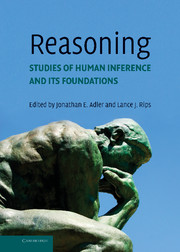Book contents
- Frontmatter
- Contents
- Preface
- List of Contributors
- Introduction: Philosophical Foundations
- PART I FOUNDATIONS OF REASONING
- Section 1 Some Philosophical Viewpoints
- Section 2 Fallacies and Rationality
- 5 When Rationality Fails
- 6 Extensional Versus Intuitive Reasoning: The Conjunction Fallacy in Probability Judgment
- 7 Can Human Irrationality Be Experimentally Demonstrated?
- 8 Breakdown of Will
- PART II MODES OF REASONING
- PART II INTERACTIONS OF REASONING IN HUMAN THOUGHT
- Index
- References
6 - Extensional Versus Intuitive Reasoning: The Conjunction Fallacy in Probability Judgment
Published online by Cambridge University Press: 05 June 2012
- Frontmatter
- Contents
- Preface
- List of Contributors
- Introduction: Philosophical Foundations
- PART I FOUNDATIONS OF REASONING
- Section 1 Some Philosophical Viewpoints
- Section 2 Fallacies and Rationality
- 5 When Rationality Fails
- 6 Extensional Versus Intuitive Reasoning: The Conjunction Fallacy in Probability Judgment
- 7 Can Human Irrationality Be Experimentally Demonstrated?
- 8 Breakdown of Will
- PART II MODES OF REASONING
- PART II INTERACTIONS OF REASONING IN HUMAN THOUGHT
- Index
- References
Summary
Uncertainty is an unavoidable aspect of the human condition. Many significant choices must be based on beliefs about the likelihood of such uncertain events as the guilt of a defendant, the result of an election, the future value of the dollar, the outcome of a medical operation, or the response of a friend. Because we normally do not have adequate formal models for computing the probabilities of such events, intuitive judgment is often the only practical method for assessing uncertainty.
The question of how lay people and experts evaluate the probabilities of uncertain events has attracted considerable research interest in the last decade (see, e.g., Einhorn & Hogarth, 1981; Kahneman, Slovic, & Tversky, 1982; Nisbett & Ross, 1980). Much of this research has compared intuitive inferences and probability judgments to the rules of statistics and the laws of probability. The student of judgment uses the probability calculus as a standard of comparison much as a student of perception might compare the perceived sizes of objects to their physical sizes. Unlike the correct size of objects, however, the “correct” probability of events is not easily defined. Because individuals who have different knowledge or who hold different beliefs must be allowed to assign different probabilities to the same event, no single value can be correct for all people. Furthermore, a correct probability cannot always be determined even for a single person.
- Type
- Chapter
- Information
- ReasoningStudies of Human Inference and its Foundations, pp. 114 - 135Publisher: Cambridge University PressPrint publication year: 2008
References
- 3
- Cited by



